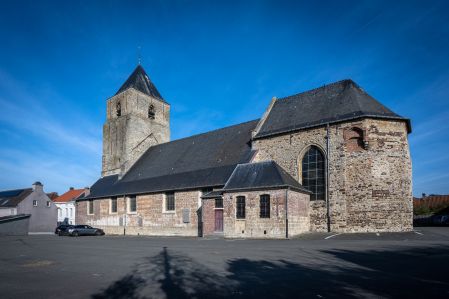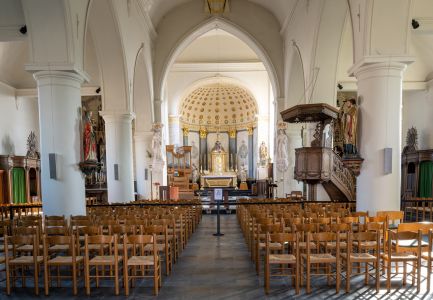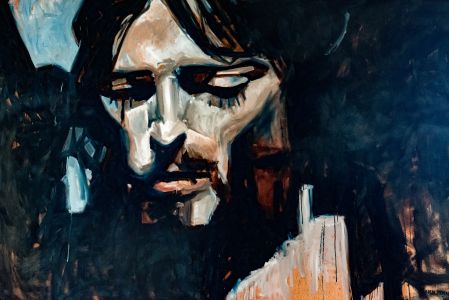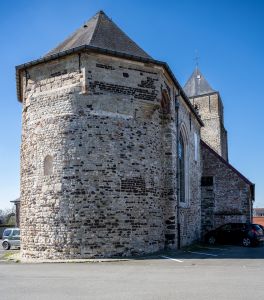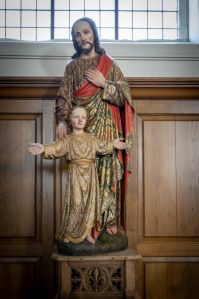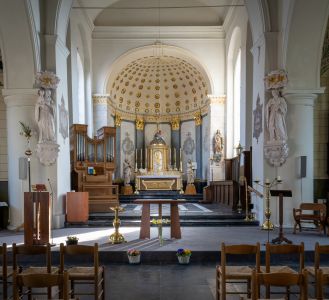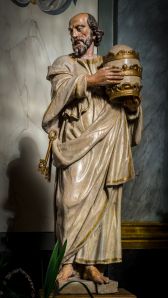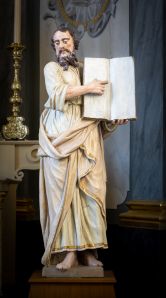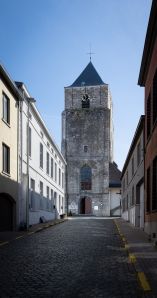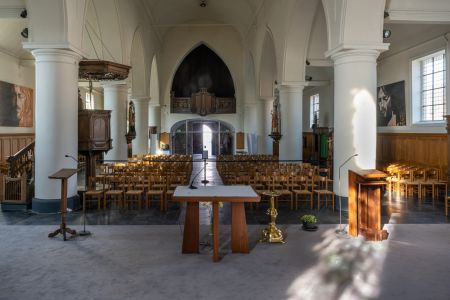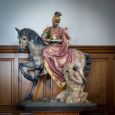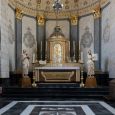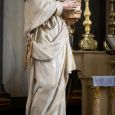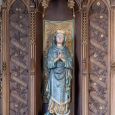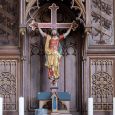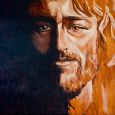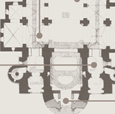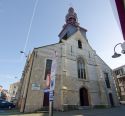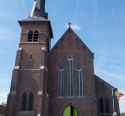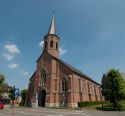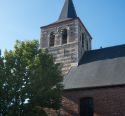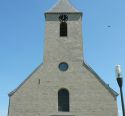Church | XI-XIX | Romanesque, Gothic | Catholic Church

Map
Opening hours
01 January - 31 December
Mon 9.30 - 17.00
Tue 9.30 - 17.00
Wed 9.30 - 17.00
Thu 9.30 - 17.00
Fri 9.30 - 17.00
Sat 9.30 - 17.00
Sun 9.30 - 17.00
Religious offices
Description
Like many old churches, Saint Martin (Martin of Tours) was also chosen as patron saint of the church. His depiction as a horseman sharing his cloak with a beggar at the gates of the city of Amiens, was therefore chiseled into the entrance gate. One can see this same image returning in the left aisle and also as a fresco in the choir. Later (16th century) he received some competition from Saint Wilgefortis who is depicted on the side altar to the right. The statue of Saint Uncumber with beard on a cross (from 1646) was rescued from the fire of 1728.
Excavations in and near the church make one assume that the first church building was already established here during the 9th century. The consecutive construction phases led to this result: a Gothic western tower (13th century), a Gothic three-aisled nave consisting of four bays (13th century, 15th century), a higher Romanesque choir (11th century, 12th century), a southern sacristy from the 18th century with 17th century substructure and a southern storage room (early 19th century). In the walls, one can find an enormous variety of building materials, including Roman roof tiles.
One can find an overview of the numerous paintings and statues in the brochure that is available in the church. Furthermore, one can find in the interior a renaissance tinted pulpit (17th century), four confessionals from the 18th century, choir stalls from the 19th century, and a rood screen with organ by A.F. Van Peteghem (1771), which was modified in 1914. The side wall is decorated with ancient epitaphs. The village of Velzeke offers a beautiful backdrop with historical elements but the cemetery next to the church has been replaced by an asphalt square since 1960.
KIKIRPA : Photo-library online
Photos
Remarkable elements
Statue of Saint Martin of Tours on horseback
This Roman officer of Hungarian descent, stationed in Amiens, shares his cloak with a beggar that later turns out to be Christ himself. This immediately leads to his conversion to Christianity. He later became bishop of the archdiocese of Tours.
In 1910, the statue was delivered by Van Biesbrouck from the city of Ghent.
Saint Martin of Tours is the patron saint of the church. That’s why one can also find next to the statue, a mural of Saint Martin on the north side of the high choir and also a white stone sculpture that represents Saint Martin of Tours that one can find outside on the left side of the church entrance.
The high altar
In Baroque style, gilded and accommodated with a rather large cylindrical tabernacle on which one can see a chalice with wafer and some cherubs. Below, one can see a ‘Lamb of God’ with cross. On the base, there’s an All-seeing Eye of God with halo (the God who sees me). On top, one can find a beautiful carved out Christ on the cross that stands on a globe. The origin of this piece of furniture is still unknown, but it was restored in 1734 by Lambertus Panne (for the remuneration of 18 pounds).
Originally, one even used the base as a storage place, but later the tabernacle on top was created. The pastor of Velzeke once even got reprimanded by someone who complained that the tabernacle opened at the back.
Polychromed statues of the apostles Saint Peter and Saint Paul
In 2009 and 2010, several statues and church furniture were restored, amongst which the statue of Saint Peter and Saint Paul, a statue of the Sacred Heart, a statue of Mary, Saint Joseph and Child, Saint Francis Xavier, Saint Barbara, several wooden pedestals and plaster corbels.
The most beautiful statues are that of Saint Peter and Saint Paul, dating from 1601 to 1650, sculpted in wood.
Neo-Gothic side altar of Our Lady
It was made in oak by the sculptor Camiel Lippens from Ghent in 1886. It then cost 2600 francs. With the exception of the candlesticks, it originally came with canon boards and an iron fence.
Like everywhere else, this altar stands to the women’s side of the church, to the left that is.The wooden Madonna statue is remarkably austere and beautiful. It refers to the Woman of the Apocalypse, who stands on the Crescent Moon and who conquers evil, in this case represented by a dragon. The two Latin texts correlate to the Immaculate Conception of Mary.
Neo-Gothic side altar of Saint Wilgefortis with beard.
In 1888, the altar was made by Camiel Lippens and this also for the price of 2600 francs. The tiny statue is older and dates from 1646 and was rescued from the fire in 1728.
The legend tells that Saint Wilgefortis was the daughter of a pagan king from Portugal. She was a Christian and her father wished that she would marry the king of Sicily. To avoid marrying the pagan king, Wilgefortis begged God to make her physically unattractive to men. Her prayer was answered and led to the beautiful princess growing a beard. Her father had her crucified due to her disobedience.
Modern paintings
Modern paintings of the ‘Broken Christ’ and of the ‘Resurrected Christ’ (by the local artist Koen Penninck (2016).



